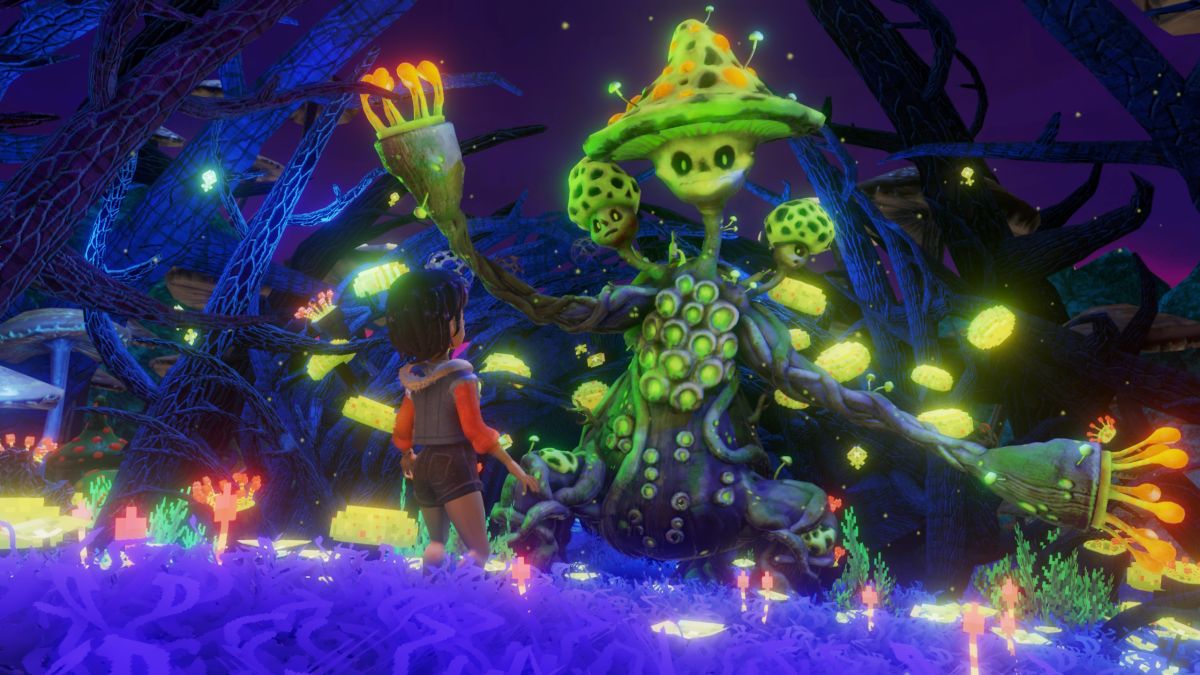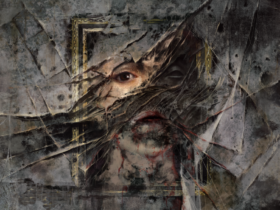ravenlock review
need to know
what is it? A hack-and-slash action-adventure game inspired by Alice in Wonderland.
release date May 4, 2023
expect to pay $25 / £19.79
developer cocoa cucumber
publisher cocoa cucumber
Reviewed on Windows 11, Nvidia 2080 Ti, Intel i9-9900k @ 4.9ghz, 32GB RAM
steam deck not support
associate Official Website(opens in a new tab)
Aesthetically at least, Ravenlok makes a great first impression, with a bright farmstead background populated by detailed (but still delightfully chunky) voxel humans. A girl sits in the shade and plays with her dog. It will ask your girl’s name and what accessories her faithful puppy will wear. The acquisition mission then begins and will continue until the moment the credits roll.
Feeling like an unfortunate statement of intent, despite being a hack-and-slash action game, Ravenlok embarks on its mock-Alice in Wonderland adventure, bouncing between two small (but beautifully detailed) Two immobile NPCs (the young heroine’s parents) and collect a series of items for them – and only – upon request. These items will stick stubbornly to the ground until your quest log asks for them to be removed; a rule that remains in effect throughout the game, frustratingly.
Before long, an object quest leads the girl (who is never seen or mentioned again except her dog) into Dunia, a magical kingdom of well-dressed rabbits, Tweedle ( There are fools and fawns), as well as an evil queen and a pack of grumpy poker. Despite some weird custom creatures and the heroine being called “Ravenlok” for her black hair, it’s a familiar, cozy wonderland with some interesting twists, like most rabbits having four hands, the Red Queen There are also caterpillars for unexplained reasons.
Ravenlock’s only moral choice, but quickly forgotten. (Image source: Future)
Despite the familiarity of its inspiration, it’s definitely a treat. Ravenlok is a pseudo-vintage aesthetic triumph. Every environment is filled with unfiltered texture-rendered detail, filled with voxelized decorations and impeccable lighting. It ran silky smooth and I didn’t experience any technical issues at all, but that’s probably because of Ravenlok’s limited ambitions. These perfect scenes are easier to appreciate because they are always viewed from the perfect angle, partly because you can only rotate the camera a few degrees in each direction. It brings the feel of a toy diorama or a voxelized stage play to these exotic environments. It feels like a world that should be viewed and admired from afar, not played in.
Until about half an hour later, Ravenlok is little more than fetching things for static characters, including having to rustle your sword and shield. When the game introduces combat (after yet another quest to acquire the sword and shield), I can’t help but feel the game creaks a bit. The combat tutorial then kicks in, fading to black, repositioning the player to a flatter, more open, less detailed area entirely designed for combat. This trick is only used from time to time, with some explorable areas having enemies to whack, but it happens often enough that it feels like Cococumber never quite figured out how to combine action with low-key exploration. It doesn’t help that the combat is almost depressingly one-note.
Get the quest before Wonderland Dunia arrives. And after that too. (Image source: Future)
snickers snacks
Simple one-note combat isn’t inherently a bad thing, as long as that note is enjoyable. Would have fun playing Dynasty Warriors or even Lego Star Wars here, and I’m a huge fan of the Ys series. Unfortunately, the notes I’ve heard most throughout Ravenlok’s entire length are sharp, artificial thumps for every possible combat interaction. Everything from breaking pottery to slicing plant monsters, and even shattering random crystal Macguffins at the end of each world, has the same squeezy, slightly distorted “jingle” that drowns out the music and superlative thoughts, without What to do now. No jump button, no combos, just a “swing sword” button.
Sadly, almost all of Ravenlok’s combat is just about facing enemies and quickly hitting the attack button to stun them into oblivion. Sometimes each enemy hits a dozen or more times, which is a lot of the same note, and very little other punctuation. There’s a block button that doesn’t seem to do much, and a dodge button to dodge telegraph boss attacks, but against normal monsters, there’s nothing like “attacking” as deeply as possible. Once the enemies get too squishy, snap back to an NPC who can convert the experience you’ve accumulated into a fixed stat increase and repeat.
Like a story in the public domain! No Cheshire cat, though. (Image source: Future)
Even the game’s four unlockable special attacks (two melee, two projectiles, bound to the four shoulder buttons on most gamepads) don’t help spice up the recipe. Manipulating the cooldown, they only speed up the process of mopping up hordes of regular enemies, and further simplify boss fights with their generous invulnerability frame. Boss fights themselves are relatively fun (at least compared to normal monsters), with smooth animations and clear attacks, but the fixed camera means it’s easy to get lost behind or under bigger monsters, again reducing fights to random swings until you reposition yourself character of.
That might seem ominous, but nothing bad happened in this game. (Image source: Future)
alice in chains
Many of these mechanical flaws are forgivable if the beautiful backgrounds and inventive creature designs are used to tell an exciting story, but sadly the plot feels as stale as the combat. Each newly introduced character stands in their assigned position, either explaining why they need Ravenlok’s help, or threatening her briefly until a fight breaks out. There’s no room for character development, and the dialogue—completely silent and handled via speech bubbles above the characters’ heads—often occurs when two participants stand side by side and face the camera, giving it a hollow pantomime feel.
No drama, no escalation, and no depth.
No drama, no escalation, and no depth. Ravenlok is an empty character in its own right, receptive to every request, and while there are occasional hints of darker things going on in Dunia’s wonderland, they go unexplored and are quickly glossed over. I’d like to attribute the sinister undercurrent that belies these moments to the writer’s intent, but the hollowness of the script (Ravenlock announces that all the strange creatures are her friends and family, even though each exchanged only a few lines of dialogue) suggests that here Nothing of substance. It sounds hollow even as a child’s play, with some choice grammar mistakes and missing words in the script accentuating the amateurish vibe.
background yes Gorgeous, mixed polygon and matte painting. (Image source: Future)
I wish my complaints would end here, but probably the most off-putting part of the whole Ravenlok experience is how disjointed everything feels. Each new environment is beautiful, but they are often connected in the most tenuous ways. Each of the three worlds can take you there via a teleporter belt or an NPC, which fades to black and suddenly switches to a new location. I could have accepted the weird and surreal dreamlike connections between areas, but Ravenlok just jumps from screen to screen. Shockingly, some boss fights also take place in completely different arenas from where the enemies are encountered, only switching back to “reality” in the event the boss is defeated.
nothing bad once From Poking Strange Magic Crystals. (Image source: Future)
Ravenlok’s limited content, already sparse, felt like it was stretched to the limit in the final hour. The clock tower area in the late game was introduced as a boss dash of sorts, requiring you to claim three coins from three floors in order to advance. There are fights on the first two floors, and on the third floor, an NPC randomly hands you the third coin. In the same room, you have to plug them into the machine to continue, and nothing happens. It turns out that you need to talk to another character in the same room to open the exit for you. Any sense of upgrades or drama is completely ruined, even the area’s impressive environment and boss designs.
The theater is one of the most comfortable places in Ravenlock. (Image source: Future)
handsome pig
This random padding continues until the end of the game, including a room where you can reach a switch that’s so high that you need to pull a lever two steps away from it to lower it. There’s so little to do in each environment that adding an extra button prompt to the scene still doubles the amount of interaction.
The last segment – the attack on the queen’s castle – feels like Ravenlok’s game budget is completely spent. As always, the setting is immaculate, but there are only five rooms in the entire final area. An entry courtyard, a lobby, two side rooms, and the final boss room, during which the game attempts to introduce a (fortunately short and simple) stealth section and five new enemy types. There is so little room for these to spawn all the new enemy types at the same time. In order to defeat them all (necessary to progress), I had to flip a switch to change the types that appeared in the rooms on either side.
Some battles are pure chaos. Just mash until the health bar breaks. (Image source: Future)
It pains me to be as critical of Ravenlok as I am, because it’s clearly a game of passion and clear artistic intent. But throughout its 5-6 hour runtime, I never wavered from the sense that this is a showcase of environmental art (and a beautiful, polished one at that) with minimal gameplay on it. It’s kid-friendly, both in tone and difficulty, but it pales in comparison to other games aimed at a younger crowd. Like the best china tea sets, it’s best displayed on a shelf to be admired rather than served at a party.
Find more articles in our categories Gaming & News & Anime.
Thanks for visiting we hope our article ravenlock review
, don’t forget to share the article on Facebook, instagram and whatsapp with the hashtags ☑️ #ravenlock #review ☑️!














Leave a Review